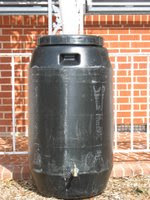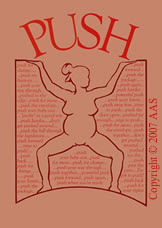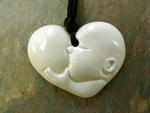When I interviewed Dr. George M. Morley, M.D., he shared with me the story of his granddaughter's recent birth. She was born by cesarean and the D.O. who attended the birth worked with Dr. Morley to allow the baby's placenta to birth before clamping and cutting the cord. Dr. Robert Oliver proposed Humanizing Cesarean Birth years ago.
Humanizing cesarean birth was poo-pooed by any physician that any woman I have known has tried to communicate to about her baby's birth. They don't want to do it. Now the UK, as usual, is promoting it ....
It is all about what I have been advocating here and on another blog that won't allow the posts about such things to stay up --- birth is not safe for the baby, at home or at the hospital, UNTIL the parents and caregivers embrace the knowledge that the baby experiences birth, feels it and remembers it, and UNTIL medical caregivers in particular acknowledge human physiology and realize that the baby needs it's full transfusion of blood, and to be at the mother's breast. No matter what happens, medically and morally responsible mother-baby care has this has it's core purpose -- making birth humane and safe for the baby. If obstetricians can do a humane cesarean surgery, anyone, including neonatal personnel can do it too --do whatever you do with the awareness and acknowledgment that birth is the baby's experience.
I would take it one step further ... prepare the medical staff and parents to communicate with the baby. In my film I'll feature a homebirth with baby who needs to be suctioned. In the hospital babies are routinely suctioned, but not in homebirths. This baby met the criteria established by the American Academy of Pediatrics (ignored by virtually every hospital including the BIG Kahuna hospitals that suctioned my grandsons under the GUISE of "meconium risk"), and that is a NON-vigorous baby who is not crying. The footage will show a midwife and baby doula preparing and talking to the baby and the pace is slowed down to accommodate the baby's needs while someone is talking TO the baby. This helps everyone in the room to slow down.
The following is from a poster, Sharon, on another blog (where homebirth and midwifery is constantly negated with false claims) highlighting what we would call a conscious Cesarean:
(Notice the "pace" of the surgery and feel your own sensations ... especially if you have performed, assisted, or experienced a cesarean ...)
... I could almost choose a caesarean after reading this article! I particularly like the description of the slow delivery of the baby, allowing him/her to establish breathing whilst still half in utero and attached to the placental circulation and the mother seeing her baby emerge and seeing their sex at the same time as the delivery team. There are some lovely pictures too.
http://www3.interscience.wiley.c...78270/ HTMLSTART
The natural caesarean: a woman-centred technique "Surgery starts with the screen up, and sterile routines observed as usual. After uterine incision, the drape is lowered and the head of the table raised to enable the mother to watch the birth.
As the fetal head enters the abdominal incision, the operative field is cleaned of blood and the partner is invited to stand to observe the birth. The principle for the surgeon is then hands-off, as the baby autoresuscitates: breathing air through the exteriorised mouth and nose, while its trunk still in utero remains attached to the placental circulation. This delay of a few minutes allows pressure from the uterus and maternal soft tissues to expel lung liquid (Figure 1), mimicking what happens at vaginal delivery. Once crying, the baby's shoulders are eased out, and the baby then frequently delivers his/her own arms with an expansive gesture.
Concurrently, the baby's torso tamponades the uterine incision, minimising bleeding. The baby is next left supported for up to a minute, allowing the mother to observe her child. The half-delivered fetus frequently cries but if not, the obstetrician observes its breathing, colour, tone and movement to indicate wellbeing. The rest of the delivery is achieved through a combination of passive expulsion by the contracting uterus and active assistance: the baby wriggles out while its head and torso are supported by the obstetrician. This enables the mother to watch the birth and ascertain the sex of her baby at the same time as the delivery team, replicating the situation at vaginal birth.
Early skin-to-skin contact
Once the baby is finally 'born' and wellbeing again confirmed, the cord is clamped and cut in view of the parents. The anaesthetist/anaesthetic assistant clears the mother's clothing from her chest, and the midwife positions him/herself at the top of the bed beside the mother's head. Still scrubbed, the midwife receives the baby directly from the surgeon to prevent contamination (Figure 3). The woman should be warned not to reach out for her baby, as this risks touching the obstetrician. The baby is laid prone between the mother's breasts, dried with a warmed towel and kept warm with fresh towels and bubble wrap. After a plastic clamp is applied, the partner can cut the remaining cord if he wishes.
Labelling and vitamin K administration are accomplished with the baby on the mother's chest. The baby is positioned so that he/she can begin to suckle. The midwife remains near the head end to monitor the baby and reassure the parents. The baby is only weighed when surgery is finished, and given to the partner while the mother is transferred to her bed. Skin-to-skin contact is then re-established with the baby in the same position."
The Other Side of the Glass
Part One was officially released June 2013 in digital distribution format.
To purchase to to www.theothersideoftheglass.com
If you were a donor and want to download your copy send an email to theothersideoftheglassfilm@gmail.com.
The trailer
Monday, September 01, 2008
Subscribe to:
Post Comments (Atom)
"Soft is the heart of a child. Do not harden it."
A public awareness reminder that things that happen behind the scenes, out of our sight, aren't always as rosy as we might think them to be. Perhaps its a restaurant cook who accidentally drops your burger
on the floor before placing it on the bun and serving it to you. Here it's an overworked apathetic (pathetic) nurse giving my newborn daughter her first bath.
Please comment and rate this video, so as to insure that it is viewed as widely as possible, perhaps to prevent other such abuse. -- The mother who posted this YouTube. How NOT to wash a baby on YouTube
Are you going to try to tell me that "babies don't remember?" There is no difference to this baby's experience and the imprinting of her nervous system/brain and one that is held and cleaned by the mother or father either at the hospital or at home?
By the way, this is probably NOT the baby's first bath. The nurse is ungloved. Medical staff protocol is that they can't handle a baby ungloved until is has been bathed (scrubbed if you've seen it) because the baby is a BIO-HAZARD -- for them. Never mind that the bio-hazard IS the baby's first line of defense against hospital germs.
Missouri Senator Louden Speaks
Finally, A Birth Film for Fathers
Part One of the "The Other Side of the Glass: Finally, A Birth Film for and about Men" was released June, 2013.
Through presentation of the current research and stories of fathers, the routine use of interventions are questioned. How we protect and support the physiological need of the human newborn attachment sequence is the foundation for creating safe birth wherever birth happens.
Based on knowing that babies are sentient beings and the experience of birth is remembered in the body, mind, and soul, fathers are asked to research for themselves what is best for their partner and baby and to prepare to protect their baby.
The film is designed for midwives, doulas, and couples, particularly fathers to work with their caregivers. Doctors and nurses in the medical environment are asked to "be kind" to the laboring, birthing baby, and newborn. They are called to be accountable for doing what science has been so clear about for decades. The mother-baby relationship is core for life. Doctors and nurses and hospital caregivers and administrators are asked to create protocols that protect the mother-baby relationship.
Men are asked to join together to address the vagaries of the medical system that harm their partner, baby and self in the process of the most defining moments of their lives. Men are asked to begin to challenge the system BEFORE they even conceive babies as there is no way to be assured of being able to protect his loved ones once they are in the medical machine, the war zone, on the conveyor belt -- some of the ways that men describe their journey into fatherhood in the medicine culture.
Donors can email theothersideoftheglassfilm@gmail.com to get a digital copy.
Through presentation of the current research and stories of fathers, the routine use of interventions are questioned. How we protect and support the physiological need of the human newborn attachment sequence is the foundation for creating safe birth wherever birth happens.
Based on knowing that babies are sentient beings and the experience of birth is remembered in the body, mind, and soul, fathers are asked to research for themselves what is best for their partner and baby and to prepare to protect their baby.
The film is designed for midwives, doulas, and couples, particularly fathers to work with their caregivers. Doctors and nurses in the medical environment are asked to "be kind" to the laboring, birthing baby, and newborn. They are called to be accountable for doing what science has been so clear about for decades. The mother-baby relationship is core for life. Doctors and nurses and hospital caregivers and administrators are asked to create protocols that protect the mother-baby relationship.
Men are asked to join together to address the vagaries of the medical system that harm their partner, baby and self in the process of the most defining moments of their lives. Men are asked to begin to challenge the system BEFORE they even conceive babies as there is no way to be assured of being able to protect his loved ones once they are in the medical machine, the war zone, on the conveyor belt -- some of the ways that men describe their journey into fatherhood in the medicine culture.
Donors can email theothersideoftheglassfilm@gmail.com to get a digital copy.
Buy the film at www.theothersideoftheglass.com.
The film focuses on the male baby, his journey from the womb to the world and reveals healing and integrating the mother, father, and baby's wounded birth experience. The film is about the restoring of our families, society, and world through birthing loved, protected, and nurtured males (and females, of course). It's about empowering males to support the females to birth humanity safely, lovingly, and consciously.
Finally, a birth film for fathers.
The film focuses on the male baby, his journey from the womb to the world and reveals healing and integrating the mother, father, and baby's wounded birth experience. The film is about the restoring of our families, society, and world through birthing loved, protected, and nurtured males (and females, of course). It's about empowering males to support the females to birth humanity safely, lovingly, and consciously.
Finally, a birth film for fathers.
What People Are Saying About the FIlm
Well, I finally had a chance to check out the trailer and .. wow! It's nice that they're acknowledging the father has more than just cursory rights (of course mom's rights are rarely acknowledged either) and it's great that they're bringing out the impact of the experience on the newborn, but I'm really impressed that they're not shying away from the political side.
They are rightly calling what happens in every American maternity unit, every day, by its rightful name - abuse. Abuse of the newborn, abuse of the parents and their rights, abuse of the supposedly sacrosanct ethical principal of patient autonomy and the medico-legal doctrine of informed consent, which has been long ago discarded in all but name. I love it!
In the immortal words of the "shrub", "bring it on!" This film needs to be shown and if I can help facilitate or promote it, let me know.
Father in Asheville, NC
Thanks for sharing this. It was very touching to me. I thought of my brother-in-law standing on the other side of the glass when my sister had to have a C-section with her first child because the doctor was missing his golf date. I'll never forget his pacing back and forth and my realizing that he was already a father, even though he hadn't been allowed to be with his son yet.
Margaret, Columbia, MO
They are rightly calling what happens in every American maternity unit, every day, by its rightful name - abuse. Abuse of the newborn, abuse of the parents and their rights, abuse of the supposedly sacrosanct ethical principal of patient autonomy and the medico-legal doctrine of informed consent, which has been long ago discarded in all but name. I love it!
In the immortal words of the "shrub", "bring it on!" This film needs to be shown and if I can help facilitate or promote it, let me know.
Father in Asheville, NC
OMG'ess, I just saw the trailer and am in tears. This is so needed. I watch over and over and over as fathers get swallowed in the fear of hospitals birth practice. I need a tool like this to help fathers see how very vital it is for them to protect their partner and baby. I am torn apart every time I see a father stand back and chew his knuckle while his wife is essentially assaulted or his baby is left to lie there screaming.
Please send me more info!!!!
Carrie Hankins
CD(DONA), CCCE, Aspiring Midwife
720-936-3609
Thanks for sharing this. It was very touching to me. I thought of my brother-in-law standing on the other side of the glass when my sister had to have a C-section with her first child because the doctor was missing his golf date. I'll never forget his pacing back and forth and my realizing that he was already a father, even though he hadn't been allowed to be with his son yet.
Margaret, Columbia, MO
In case you don't find me here
Soon, I'll be back to heavy-duty editing and it will be quiet here again. I keep thinking this blog is winding down, and then it revives. It is so important to me.
I wish I'd kept a blog of my journey with this film this past 10 months. It's been amazing.
I have a new blog address for the film, and will keep a journal of simple reporting of the journey for the rest of the film.
www.theothersideoftheglassthefilm.blogspot.com
I'll be heading east this week to meet with a group of men. I plan to post pictures and clips on the film blog.
I'll keep up here when I can -- when I learn something juicy, outrageous, or inspiring related to making birth safer for the birthing baby.
I wish I'd kept a blog of my journey with this film this past 10 months. It's been amazing.
I have a new blog address for the film, and will keep a journal of simple reporting of the journey for the rest of the film.
www.theothersideoftheglassthefilm.blogspot.com
I'll be heading east this week to meet with a group of men. I plan to post pictures and clips on the film blog.
I'll keep up here when I can -- when I learn something juicy, outrageous, or inspiring related to making birth safer for the birthing baby.
Review of the film
Most of us were born surrounded by people who had no clue about how aware and feeling we were. This trailer triggers a lot of emotions for people if they have not considered the baby's needs and were not considered as a baby. Most of us born in the US were not. The final film will include detailed and profound information about the science-based, cutting-edge therapies for healing birth trauma.
The full film will have the interviews of a wider spectrum of professionals and fathers, and will include a third birth, at home, where the caregivers do a necessary intervention, suctioning, while being conscious of the baby.
The final version will feature OBs, RNs, CNMs, LM, CPM, Doulas, childbirth educators, pre and perinatal psychologists and trauma healing therapists, physiologists, neurologists, speech therapists and lots and lots of fathers -- will hopefully be done in early 2009.
The final version will include the science needed to advocated for delayed cord clamping, and the science that shows when a baby needs to be suctioned and addresses other interventions. Experts in conscious parenting will teach how to be present with a sentient newborn in a conscious, gentle way -- especially when administering life-saving techniques.
The goal is to keep the baby in the mother's arms so that the baby gets all of his or her placental blood and to avoid unnecessary, violating, and abusive touch and interactions. When we do that, whether at home or hospital, with doctor or midwife, the birth is safe for the father. The "trick" for birthing men and women is how to make it happen in the hospital.
The full film will have the interviews of a wider spectrum of professionals and fathers, and will include a third birth, at home, where the caregivers do a necessary intervention, suctioning, while being conscious of the baby.
The final version will feature OBs, RNs, CNMs, LM, CPM, Doulas, childbirth educators, pre and perinatal psychologists and trauma healing therapists, physiologists, neurologists, speech therapists and lots and lots of fathers -- will hopefully be done in early 2009.
The final version will include the science needed to advocated for delayed cord clamping, and the science that shows when a baby needs to be suctioned and addresses other interventions. Experts in conscious parenting will teach how to be present with a sentient newborn in a conscious, gentle way -- especially when administering life-saving techniques.
The goal is to keep the baby in the mother's arms so that the baby gets all of his or her placental blood and to avoid unnecessary, violating, and abusive touch and interactions. When we do that, whether at home or hospital, with doctor or midwife, the birth is safe for the father. The "trick" for birthing men and women is how to make it happen in the hospital.






No comments:
Post a Comment